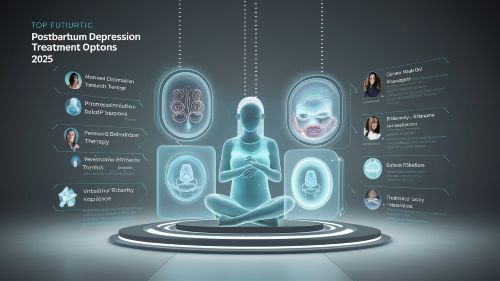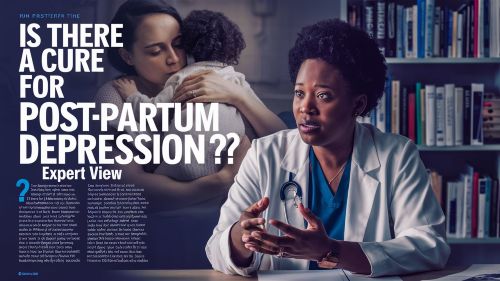In the depths of postpartum depression (PPD), when every day feels like a battle, one question echoes louder than any other: Is there a cure?
It’s a question born from a place of deep longing. You don’t just want to feel better; you want to be well. You want to know if this debilitating illness can be eradicated from your life completely, like a cured infection, so you never have to face it again. You want a finish line.
As experts in the field of perinatal mental health will tell you, the answer to this question is both simple and complex. It requires us to look closely at the word “cure” and replace it with a more accurate, and ultimately more hopeful, framework: recovery and remission.
In this expert-informed guide, we will tackle this crucial question head-on. We’ll explore what recovery from PPD truly means, what the path to getting there looks like, and why a life free from the symptoms of PPD is not just a dream, but the expected outcome of proper treatment.
[Insert a powerful, hopeful image here: a path leading out of a dark forest into the light, or a sunrise breaking over a misty landscape.]
The Critical Distinction: ‘Cure’ vs. ‘Recovery’
In medicine, the word “cure” typically implies a permanent eradication of a disease. You take an antibiotic for a bacterial infection, and once it’s gone, it’s gone. You don’t expect it to come back unless you are re-infected.
Depression, including PPD, doesn’t work that way. It’s more like a chronic condition such as asthma or migraines.
Expert Takeaway: The Asthma Analogy
Think of it like this: A person with asthma can, with the right treatment and management plan, live a full and active life completely free of symptoms. They are in remission. They may not have had an asthma attack in years. But they still have the underlying biological vulnerability. Under certain conditions—like exposure to a trigger—their symptoms could return.
Postpartum Depression is similar. The goal of treatment is to achieve full remission, a state where your symptoms are gone and you have returned to your normal level of functioning. You feel like yourself again. For all intents and purposes, you are well. But the vulnerability to a future depressive episode may remain.
This distinction isn’t meant to be discouraging. It’s the opposite. It’s an empowering framework that shifts the focus from a magical, one-time “cure” to an active, manageable process of getting well and staying well.

So, the real question isn’t “Can PPD be cured?” The real, more hopeful question is: “Can I fully recover from PPD and live a life free of its symptoms?”
To that, the answer from experts across the board is a resounding YES.
The Pillars of Achieving Full Remission
Full recovery—or remission—from postpartum depression is the standard, expected outcome when the illness is treated effectively. This isn’t about luck; it’s about engaging with evidence-based treatments that target the illness from multiple angles.
Pillar 1: Biological Intervention (Rebalancing the Brain)
PPD is a biological illness rooted in brain chemistry. The dramatic hormonal shifts after childbirth, combined with severe sleep deprivation, dysregulate key neurotransmitter systems. Treatment aims to correct this imbalance.
- Medication: This is the cornerstone of biological treatment for moderate to severe PPD.
- SSRIs (Selective Serotonin Reuptake Inhibitors): These trusted medications (like Zoloft, Prozac) work by gradually increasing serotonin levels, which helps regulate mood. They are highly effective but require 4-8 weeks to work.
- Neurosteroids (like Zuranolone): This newer class of medication offers a rapid reset. By targeting the GABA system—the brain’s primary calming network—it can bring significant symptom relief in a matter of days. [Link to your 2025 Treatment Options article].
- Advanced Brain Stimulation: For treatment-resistant PPD, options like Transcranial Magnetic Stimulation (TMS) offer a non-invasive way to stimulate underactive areas of the brain, while Electroconvulsive Therapy (ECT) remains the most rapidly effective treatment for severe or psychotic PPD.
Pillar 2: Psychological Skills (Retraining the Mind)
Medication can lift the fog, but therapy gives you the map and compass to navigate your way out. It provides the skills to manage your thoughts and emotions long-term.
- Cognitive-Behavioral Therapy (CBT): This approach helps you identify the toxic, automatic negative thoughts PPD creates (“I’m a bad mom,” “This is all my fault”) and systematically retrain your brain to challenge and replace them with more realistic and compassionate ones.
- Interpersonal Therapy (IPT): This therapy helps you address the profound shifts in relationships and identity that come with motherhood—areas that are often a major source of stress and sadness.
Therapy isn’t just talking; it’s learning lifelong skills that not only help you recover from PPD but also make you more resilient against future stress.
The “Whole Person” Approach to Staying Well
A true, lasting recovery goes beyond just clinical treatment. It involves nurturing the three core aspects of your being: the biological, the psychological, and the social.
[Use the WordPress “Columns” block to create a three-column layout for the following section. Each pillar gets its own column.]
The Biological Pillar
Goal: Regulate Your Physical Systems.
This involves prioritizing the fundamentals that support a healthy brain.
- Sleep: Make sleep a non-negotiable priority. This is the single most powerful thing you can do for your mental health. Enlist your partner, family, or a postpartum doula to ensure you get at least one 4-5 hour consolidated block of sleep every 24 hours.
- Nutrition: Eat regular, nutrient-dense meals. Stabilizing your blood sugar prevents energy crashes that can mimic and worsen anxiety and depression.
- Movement: Gentle, consistent movement—like a daily walk outside—is a proven mood booster. It releases endorphins and helps regulate your nervous system.
The Psychological Pillar
Goal: Cultivate Self-Compassion and Resilience.
This is about changing your internal relationship with yourself.
- Lower Expectations: Release the pressure to be a “perfect” mother. In the recovery phase, your only job is to care for yourself and your baby. A clean house or a gourmet meal can wait.
- Practice Mindfulness: Small moments of mindfulness—focusing on your breath, the feeling of a warm cup in your hands—can help ground you when your mind is racing or spiraling.
- Challenge Guilt: Recognize that the guilt you feel is a symptom of the illness, not a reflection of your character. A therapist can give you powerful tools to dismantle this guilt.
The Social Pillar
Goal: Build Your Village.
PPD thrives in isolation. Connection is the antidote.
- Ask for Specific Help: Don’t just say “I’m struggling.” Say, “Can you come over and hold the baby for an hour so I can shower?” or “Could you bring us dinner on Tuesday?” People want to help; they often just don’t know how.
- Find Your People: Join a new moms’ support group, either in person or online. Connecting with other women who get it is incredibly validating and breaks down the wall of shame.
- Communicate with Your Partner: Share what you’re feeling, even if it’s scary. Let them in. [Link to your article for partners].
A Story of Remission
“For a long time, I was terrified my PPD would come back. After about 9 months of medication and weekly therapy, I felt like myself again, but I was always looking over my shoulder. My therapist helped me see my recovery not as a fragile thing, but as a new foundation. I had new skills. I knew my triggers. I learned how to ask for help. When we had our second child, I had a plan in place. I felt anxious sometimes, sure, but the deep, dark pit of depression never returned. I wasn’t ‘cured,’ but I was recovered. I was resilient.”
— Megan, a mom of two
Life After PPD: The Question of Relapse

This is the heart of the “cure” question. If I get better, can it come back?
The honest answer is yes, it can. Having one episode of major depression increases your risk for another. For women who have had PPD, the risk of recurrence in a subsequent pregnancy can be as high as 50%, according to the American College of Obstetricians and Gynecologists (ACOG).
But just like with the asthma analogy, this risk is manageable and reducible. Knowledge is power.
- You Know the Signs: You’ve been through it once. You are now an expert on your own early warning signs. You can catch it early before it spirals.
- You Have a Toolkit: Through therapy, you’ve learned coping mechanisms and strategies that you didn’t have before.
- You Can Create a Proactive Plan: For a future pregnancy, you can work with your medical team to create a mental wellness plan. This might include starting therapy during pregnancy, resuming medication immediately after delivery, and lining up your support system in advance.
Being in recovery doesn’t mean you’ll never have another sad or anxious day. It means you have the tools, support, and resilience to navigate those feelings without letting them spiral into a full-blown depressive episode.
Frequently Asked Questions (FAQ)
Q1: So, is postpartum depression permanent?
No. Postpartum depression is a temporary and treatable illness. With proper treatment, you can and will recover fully. While a vulnerability may remain, the active, symptomatic phase of the illness is not permanent.
Q2: How long does it take to recover from PPD?
The timeline varies, but with effective treatment (like medication and therapy), most women see significant improvement within a few months and feel fully recovered within 6-12 months. The key is seeking help early.
Q3: What does being in “remission” from PPD feel like?
It feels like coming home to yourself. It’s not about being ecstatically happy all the time. It’s the return of your emotional range—the ability to feel joy, to be sure, but also to handle sadness or frustration without it consuming you. It’s the absence of the heavy, depressive fog and the return of energy, interest, and a secure bond with your baby.
Q4: If I feel better, can I stop my treatment?
This is a critical point. You should never stop medication without consulting your doctor. A key part of preventing relapse is continuing treatment for a period of time (often 6-12 months) after you start feeling well to solidify your recovery.
The Goal Isn’t a Cure, It’s a Full Life
Let’s return to our original question. Is there a cure for postpartum depression? No, not in the way we cure a simple infection.
But can you recover completely? Can you get back to feeling like yourself, find joy in motherhood, and live a full, vibrant life, free from the grips of depression?
Absolutely. One hundred percent. Yes.
This is the promise of treatment. This is the truth that countless women who have walked this path before you can attest to. Don’t get hung up on the word “cure.” Focus on the process of recovery. Take the first step. Reach out for help. The path to wellness is there, and it is waiting for you.
Disclaimer: This article is for informational purposes only and does not constitute medical advice. It is based on expert consensus in the psychiatric community. If you are struggling with symptoms of postpartum depression, please contact a healthcare provider, a mental health professional, or a crisis hotline immediately.
